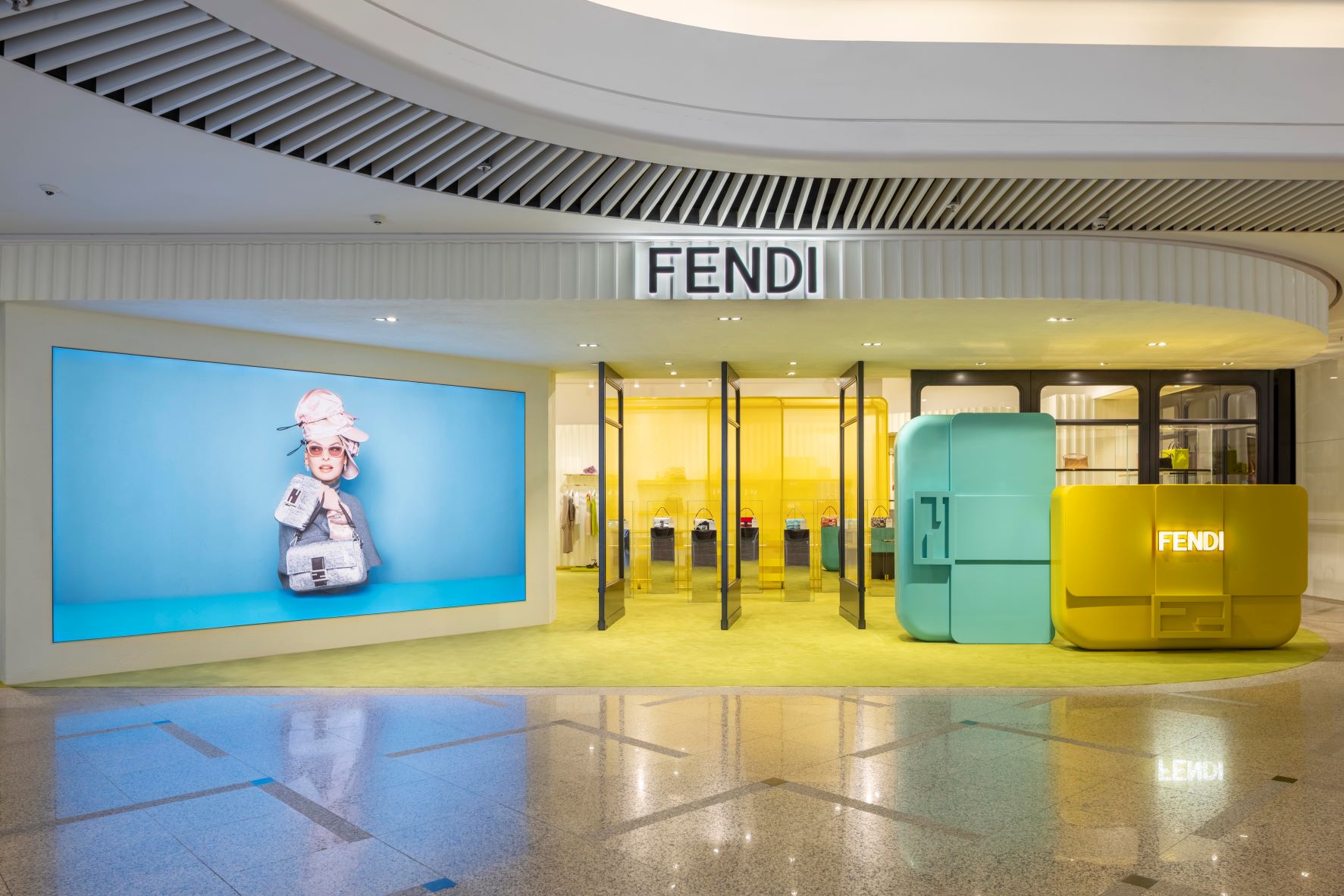Fendi is an Italian luxury fashion house founded in Rome in 1925. The brand was established by Adele and Edoardo Fendi as a fur and leather goods company. Over the years, Fendi has evolved into a renowned fashion brand known for its sophisticated designs, exquisite craftsmanship, and distinctive logo.
Fendi gained international recognition in the 1960s when Karl Lagerfeld joined the company as creative director. Lagerfeld’s innovative approach and creative vision brought a new energy to the brand. He introduced the iconic “FF” logo, which stands for “Fun Fur” and represents Fendi’s expertise in fur craftsmanship. The logo became a prominent feature across Fendi’s products and played a significant role in shaping the brand’s identity.
Fendi is celebrated for its exceptional craftsmanship and attention to detail. The brand combines traditional techniques with innovative materials and designs, creating luxurious and timeless pieces. Fendi’s product range expanded beyond fur and leather goods to include ready-to-wear clothing, accessories, handbags, shoes, eyewear, and fragrances.
One of Fendi’s most recognizable creations is the “Baguette” handbag, introduced in the late 1990s. The Baguette became an instant sensation, known for its compact shape and variety of designs, adorned with intricate embroidery, embellishments, and the iconic FF logo hardware. It exemplified Fendi’s ability to merge craftsmanship with contemporary style.
Fendi has also collaborated with various artists, designers, and celebrities, further expanding its influence and creative reach. Notable collaborations include partnerships with artists such as Jeff Koons and Richard Prince, as well as collaborations with brands like Rimowa and Fila. These collaborations have resulted in unique and limited-edition collections that blend Fendi’s heritage with new artistic expressions.
The brand has a global presence with boutiques in major fashion capitals around the world. Fendi’s runway shows are highly anticipated during international fashion weeks, where the brand unveils its latest collections and sets trends in the luxury fashion industry.
In recent years, Fendi has also embraced sustainability initiatives, committing to responsible practices and reducing its environmental impact. The brand has incorporated eco-friendly materials and processes into its collections, showcasing its dedication to environmental consciousness.
Fendi continues to be a symbol of Italian luxury and elegance, renowned for its impeccable craftsmanship, innovative designs, and enduring style. The brand’s ability to evolve while staying true to its heritage has allowed it to maintain its position as a revered name in the fashion industry.
Marketing Strategies of Fendi
In the fiercely competitive world of luxury fashion, Fendi has solidified its position as a global powerhouse. Renowned for its exquisite craftsmanship, distinctive designs, and rich heritage, Fendi’s success can be attributed, in part, to its exceptional marketing strategies. This article delves into the key marketing tactics employed by Fendi, shedding light on the brand’s ability to captivate consumers, establish a strong brand identity, and maintain its status as a leader in the luxury fashion industry.
Cultivating a Strong Brand Identity: Fendi has meticulously crafted a strong brand identity that resonates with its target audience. The brand’s distinctive logo, the “FF” monogram, is instantly recognizable and is prominently featured across its products. Fendi has successfully leveraged its heritage as a luxury fur and leather goods company, infusing it with contemporary elements to appeal to a modern clientele. By maintaining consistency in its visual branding and messaging, Fendi has effectively established itself as a symbol of opulence, craftsmanship, and Italian luxury.

Collaborations and Partnerships: Fendi has strategically collaborated with a diverse range of artists, designers, and celebrities to create unique and limited-edition collections. These collaborations not only generate excitement and buzz but also attract new audiences and reinforce Fendi’s position as an innovative and forward-thinking brand. Collaborations with renowned artists such as Jeff Koons and Richard Prince have resulted in iconic collections that fuse art and fashion, capturing the attention of both fashion enthusiasts and art connoisseurs.
Engaging Digital Presence: Fendi recognizes the importance of a strong digital presence in today’s digital era. The brand has effectively utilized social media platforms and digital marketing strategies to engage with its target audience and create a sense of exclusivity and desirability. Fendi’s social media channels showcase its latest collections, behind-the-scenes glimpses of runway shows, and collaborations, allowing followers to feel connected and involved. The brand has also embraced influencer marketing, partnering with prominent fashion influencers and celebrities to reach a wider audience and enhance brand visibility.
Spectacular Runway Shows and Events: Fendi’s extravagant runway shows and events are key elements of its marketing strategy. The brand’s fashion shows are highly anticipated and meticulously choreographed to create memorable experiences. Fendi often chooses iconic venues, embraces innovative set designs, and incorporates immersive elements that leave a lasting impression on attendees and generate media coverage. By staging these captivating spectacles, Fendi not only showcases its latest collections but also reinforces its image as a visionary and trendsetting brand.
Experiential Marketing: Fendi recognizes the value of creating immersive and personalized experiences for its customers. The brand organizes exclusive events, trunk shows, and private viewings, allowing customers to engage with the brand and its products in an intimate setting. Fendi also offers customized services, such as monogramming and made-to-order options, providing a sense of exclusivity and luxury. By prioritizing personalized experiences, Fendi establishes a strong emotional connection with its customers, fostering brand loyalty and advocacy.
Fendi’s exceptional marketing strategies have played a pivotal role in its enduring success in the luxury fashion industry. By cultivating a strong brand identity, engaging in strategic collaborations, embracing digital platforms, staging spectacular events, and prioritizing experiential marketing, Fendi continues to captivate consumers and maintain its position as a global leader. As the fashion landscape evolves, Fendi’s ability to adapt and innovate in its marketing endeavors will undoubtedly contribute to its continued growth and relevance in the ever-evolving luxury fashion market.
Marketing Mix of Fendi
In the competitive world of luxury fashion, Fendi has established itself as an iconic brand renowned for its impeccable craftsmanship and timeless designs. A crucial aspect of Fendi’s success lies in its strategic implementation of the marketing mix. This article delves into the elements of Fendi’s marketing mix, examining how the brand effectively combines product, price, place, and promotion strategies to create a powerful presence in the luxury fashion industry.
Product Strategy: Fendi’s product strategy is centered around offering a wide range of luxury fashion items that exemplify exceptional quality and craftsmanship. The brand’s ready-to-wear clothing collections showcase a harmonious blend of classic elegance and contemporary aesthetics. Fendi’s accessories, including handbags, wallets, belts, and small leather goods, are meticulously crafted using premium materials, often featuring signature details such as the FF logo hardware. The brand’s footwear collections combine style and comfort, with designs ranging from timeless classics to fashion-forward statement pieces. Fendi’s eyewear and fragrances further expand its product portfolio, allowing customers to embrace the brand’s luxurious lifestyle across different categories.
Price Strategy: Fendi adopts a premium pricing strategy to position itself as a brand of exclusivity and high quality. The price points of Fendi products reflect the craftsmanship, materials used, and the brand’s prestigious reputation. By setting higher price tags, Fendi creates an aura of luxury and aspiration, targeting affluent consumers who value the prestige and status associated with owning a Fendi item.
Place Strategy: Fendi carefully selects its distribution channels to maintain its luxury brand image. The brand operates a network of flagship stores in prominent locations worldwide, such as Milan, Paris, London, New York, and Tokyo. These flagship stores serve as physical embodiments of Fendi’s luxury aesthetic, providing a unique shopping experience and maintaining brand consistency. In addition to its own stores, Fendi products are available through exclusive partnerships with luxury department stores, high-end boutiques, and authorized online retailers. This selective approach to distribution ensures that Fendi products are accessible to its target customers while maintaining an air of exclusivity.
Promotion Strategy: Fendi employs a multi-faceted promotion strategy to build brand awareness, engage with consumers, and reinforce its luxury status. The brand leverages high-profile fashion events, such as Fashion Weeks in Milan and Paris, to showcase its latest collections and generate media coverage. Fendi’s runway shows are highly anticipated, featuring extravagant set designs and captivating presentations that capture the attention of the fashion industry and media. The brand also engages in collaborations and partnerships with influential figures in the realms of fashion, art, and entertainment. Collaborations with celebrities, fashion influencers, and artists not only enhance brand visibility but also bring a fresh perspective and cultural relevance to Fendi’s offerings. Fendi’s marketing efforts extend to print and digital media, with high-fashion editorial spreads, targeted advertising campaigns, and active social media presence. The brand effectively utilizes platforms like Instagram, Facebook, and YouTube to engage with its audience, share behind-the-scenes content, and communicate the brand’s values and aesthetic.
People, Process, and Physical Evidence: Fendi recognizes the importance of delivering exceptional customer experiences through its people, processes, and physical evidence. The brand invests in knowledgeable and well-trained staff who can provide personalized assistance, share brand stories, and offer styling advice to customers. Fendi ensures that its processes, from manufacturing to customer service, adhere to the highest standards of quality and efficiency. The brand’s physical evidence encompasses various touchpoints, including its flagship stores, which are meticulously designed to create an immersive and luxurious environment. Fendi stores feature elegant interiors, innovative displays, and ambient lighting that align with the brand’s aesthetic, enhancing the overall shopping experience and reinforcing its luxury positioning.
Fendi’s marketing mix intertwines various strategies to establish and maintain its prominence in the luxury fashion industry. Through its meticulously designed and crafted products, premium pricing, strategic distribution channels, captivating promotional activities, and focus on delivering exceptional customer experiences, Fendi has solidified its position as a global luxury fashion brand. By effectively managing the elements of the marketing mix, Fendi continues to resonate with its target audience, drive brand loyalty, and shape the perception of luxury in the fashion world.
Also Read: Marketing Strategies and Marketing Mix of Alexander McQueen
To read more content like this, subscribe to our newsletter
Go to the full page to view and submit the form.


